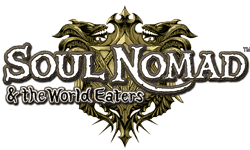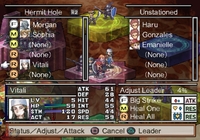|
|

|
PLATFORM
|
PlayStation 2
|
BATTLE SYSTEM
|

|
INTERACTION
|

|
ORIGINALITY
|

|
STORY
|

|
MUSIC & SOUND
|

|
VISUALS
|

|
CHALLENGE
|
Easy
|
COMPLETION TIME
|
35 Hours
|
|
OVERALL

|
Click here for scoring definitions
|
|
|
The power of the gods has been sought after for ages. What if that power was simply granted in the blink of an eye? Could you handle the power intelligently, to save the world in need, or would you let the desire for power take over your mind, your body, and even your soul? Soul Nomad & the World Eaters asks this very question.
The story starts off in a small village as you train with your faithful friend, Danette. Your hero, or heroine, wait for the day when Lady Layna will allow both of you to become guardians of the village. Finally, that day has come, but Lady Layna has a small surprise in store. Danette is allowed to select a special weapon, as is the custom of becoming a guardian, but your character is only given a single choice, an ominous looking sword. Upon taking possession of the sword, your soul becomes bound with an evil entity named Gig.
Gig is responsible for the devastation of the world 200 years ago. He commanded the three monstrosities known as the World Eaters. They command unfathomable power, and yet Gig was able to control them. Lady Layna took on Gig 200 years ago, managing to bind his soul to the sword you now carry. She has waited these 200 years, searching for someone capable of not only controlling Gig, but able to harness the power he possesses. Manage the power right, and you could rid the world of these abominations. Wield it wrong, and Gig takes over your body and soul, returning to the world as he did before. The fate of the world is in your hands, don't mess it up.
 Potential for slaughter
Potential for slaughter
|
|
What makes Soul Nomad stand out from other Nippon Ichi titles is the number of characters involved in battle. Instead of a one on one battle system, each side has an entire team. The main team is the only team on the map at the beginning of every battle. Every additional team has to be summoned into play. The only limits are the number of teams pre-made before the battle, and the GP required to summon the group onto the map. In order to place the team, there has to be enough open squares on the map to hold everyone in the party separately. Once placed, the members gather together on a single square, with the leader representing the team.
Teams are managed between battles. A team resides in a Room, which is comprised of a 3x3 grid. Usable positions in the grid are assigned randomly when the Room is created. Rooms can be changed between battles, but it's a cumbersome process. Throughout the game, the number of Rooms allowed grows at a steady pace, as well as the number of locks. Locking a Room stops it from changing when using the Change command. Using the Change command randomly creates a new Room selected from the list of available Room types. Character placement within the Room is also randomly selected from an unseen collection of patterns. These patterns vary not only in positions, but number of members allowed. The number of patterns grows, but never drops the simpler ones. Therefore, the deeper into the game, the longer it may take to find an acceptable pattern. It simply won't do to use a pattern allowing only four team members when the opponents have six, seven, or even nine members on their teams. When selecting a new Room, the process becomes little more than cycling through the options until something acceptable appears. In addition, all unlocked Rooms will change. Usually there is only one Room that can't be locked, but not always. This can be quite frustrating when trying to find a good setup.
 Thoughtful healing
Thoughtful healing
|
|
Each Room has a specific item as a default, which gives the Room a special characteristic. For example, an item could grant a boost of abilities, but the tradeoff would be that the team attacks second instead of first. Since the attacker is granted first strike, this is great for a defensive team. Other items can be added to the Room, but these last a single battle. Since the player has the chance to preview the map beforehand, they can tack on the appropriate items to give the edge in upcoming battle.
The most common items enhance members' stats based on terrain or their class. To obtain the rarer items, the player visits the item store and spends enough to fill the gauge for that store level. After that, the storekeeper can be challenged to a battle. Both sides will fight round after round until one side is defeated. If the player is victorious, better items become available, and the level of the store increases, as well as the difficulty of the storekeeper. The various cities never want to sell anything to outsiders, so this is the only way to purchase items in the game--but they're not very essential in battle.
In battle, the attacking team has the clear advantage. Not only do they get to go first, possibly taking out the number of members that can counterattack, but if the team Stamina (STM) is low enough, special attacks can be used. Every class has a default special attack, as well as special characters. Other special attacks can be earned with various combinations of party members. Trial and error is the only way to discover the combinations in-game; there's no record kept. Each team moves in turn, shown by the bar at the top of the map screen. Depending on the team and the actions taken, a team will usually have more than one play per round. The actual turns are used purely for rewards and special battle conditions when required.
All members gets to act once in battle, and this attack is based on which row they are placed on the grid. Most classes can only use two of the three rows, but all classes have a different attack for all three. There is no perfect position for a class, but some actions are more suited for the class than others. This can change a single class from melee attacking to a ranged attack to a support role. Matching weaknesses of melee versus ranged versus magic can make a large difference, and is a simple process. If you have an advantage over another team, one or two hearts will appear by their leader's name on the attack menu. Inversely, if one or two skulls are listed, your team is at a disadvantage and should be avoided. Beware that your own teams are also listed, just in case you wanted to attack your own forces for some reason. There is an on-screen warning, however, so it shouldn't happen on accident.
 Bring on the pain
Bring on the pain
|
|
The graphics peak during these battles, especially with the special attacks. While the characters are normally shown as simply animated sprites, both in dialog and in battle, the special attacks are a spasm of color and bright patters, dealing heavy damage to the targets. Obviously, the most impressive-looking ones come from the special characters. Even the normal battles are exciting, but unless you constantly mix up attacks, it can get a bit repetitive. The battles are over quickly.
The game sounds decent overall, but nothing to write home about. Thinking back, not many musical pieces stand out, but the voice acting was high quality. Only one or two characters sounded flat out of an abundance of spoken dialog. On the battlefield, each team starts off with a small audible sound, which does get a bit straining on the ears when facing twelve of the same monster class. More diversity in the shouts of special attacks would be welcome as well.
Lovers of the Disgaea series shouldn't hesitate to pick this up--Soul Nomad & the World Eaters is more of a good thing. For the rest of us, Soul Nomad is a quirky strategy RPG with a good story that will keep you entertained throughout. Even with its flaws, this is a title worth playing if you like strategy RPGs.
Review Archives
|









